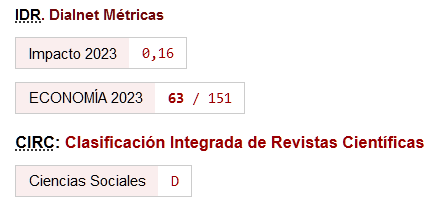Balance ambiental del Corredor Norte del Tren de Alta Velocidad de España: un enfoque de Análisis de Ciclo de Vida
DOI:
https://doi.org/10.46661/rec.10156Palabras clave:
Tren de alta velocidad, Movilidad Sostenible, Análisis de Ciclo de Vida (ACV), Impacto ambiental, Consumo energéticoResumen
España es el segundo país del mundo con más kilómetros de alta velocidad construidos y en servicio del mundo. El Tren de Alta Velocidad (AV) se ha presentado como el medio de transporte sostenible y con más potencial para reducir las emisiones de gases de efecto invernadero (GEI) y para el ahorro energético. La mayoría de estudios que se han realizado sobre este modo de transporte han puesto la atención en analizar y estimar estos ahorros en términos de operación de la red obviando, sin embargo, las cargas asociadas. a la construcción de la infraestructura.
Este artículo analiza las cargas ambientales de construcción y operación del Corredor Norte de AV y verifica si su construcción está justificada en términos de reducción de impactos ambientales y reducción de consumo energético. Para ello integra en el estudio la fase de construcción y mantenimiento de la línea, junto a la de operación. Más concretamente, el estudio se basa en la metodología del análisis de ciclo de vida (ACV), que incluye el cálculo de las cargas asociadas a la construcción de la infraestructura y las reparte a lo largo de su vida útil.
Este estudio concluye que esta línea Norte de alta velocidad no compensará, durante su vida útil, los impactos ambientales generados en su fase de construcción y mantenimiento, ni tampoco contribuirá a un ahorro energético neto
Descargas
Citas
ADIF. (2020). Adif—Líneas de alta velocidad. ADIF Alta Velocidad. http://www.adifaltavelocidad.es/es_ES/
infraestructuras/lineas_de_alta_velocidad/lineas_de_alta_velocidad.shtml
Adra, N., Michaux, J.-L., & André, M. (2010). Analysis of the load factor and the empty running rate for road transport. Artemis—Assessment and reliability of transport emission models and inventory systems. [ResearchGate]
Akerman, J. (2011). The role of high-speed rail in mitigating climate change – The Swedish case Europabanan from a life cycle perspective. Transportation Research Part D: Transport and Environment, 16(3), 208-217. [https://doi.org/10.1016/j.trd.2010.12.004] DOI: https://doi.org/10.1016/j.trd.2010.12.004
Banar, M., & Özdemir, A. (2015). An evaluation of railway passenger transport in Turkey using life cycle assessment and life cycle cost methods. Transportation Research Part D: Transport and Environment, 41, 88-105. [https://doi.org/10.1016/j.trd.2015.09.017] DOI: https://doi.org/10.1016/j.trd.2015.09.017
Barnes, E. (2014). California High Speed Resilience to Climate Change. En Center for Earth Systems Engineering and Management. [http://hdl.handle.net/2286/R.I.25239]
Baron, T., Martinetti, G., & Pépion, D. (2011). Carbon footprint of high speed rail. International Union of Railways (UIC). [http://trid.trb.org/view.aspx?id=1134978]
Betancor, O., & Llobet, G. (2015). Contabilidad financiera y social de la alta velocidad en España. FEDEA: Área de infraestructuras y Transportes.
Bueno, G., Hoyos, D., & Capellán-Pérez, I. (2017). Evaluating the environmental performance of the high speed rail project in the Basque Country, Spain. Research in Transportation Economics, 62, 44-56. [https://doi.org/10.1016/j.retrec.2017.02.004] DOI: https://doi.org/10.1016/j.retrec.2017.02.004
California High-Speed Rail Authority. (2016). California High-Speed Rail Sustainability Report. 54.
Chang, B., & Kendall, A. (2011). Life cycle greenhouse gas assessment of infrastructure construction for California’s high-speed rail system. Transportation Research Part D: Transport and Environment, 16(6), 429-434. [https://doi.org/10.1016/j.trd.2011.04.004] DOI: https://doi.org/10.1016/j.trd.2011.04.004
Chester, M., & Horvath, A. (2010). Life-cycle assessment of high-speed rail: The case of California. Environmental Research Letters, 5(1), 014003. [https://doi.org/10.1088/1748-9326/5/1/014003] DOI: https://doi.org/10.1088/1748-9326/5/1/014003
Cornet, Y., Dudley, G., & Banister, D. (2017). High Speed Rail: Implications for carbon emissions and biodiversity. Case Studies on Transport Policy. [https://doi.org/10.1016/j.cstp.2017.08.007] DOI: https://doi.org/10.1016/j.cstp.2017.08.007
Cour des Comptes. (2014). La grande vitesse ferroviaire: Un modele porte au-dela de sa pertinence. [https://www.ccomptes.fr/sites/default/files/EzPublish/20141023_rapport_grande_vitesse_ferroviaire.pdf]
Cuenot, F. (2016). Carbon Footprint of Railway Infraestructure: Comparing existing methodologies on typical corridors. UIC-ETF, 51.
De Rus, G. (2011). The BCA of HSR: Should the Government Invest in High Speed Rail Infrastructure? Journal of Benefit-Cost Analysis, 2(1), 1-28. [https://doi.org/10.2202/2152-2812.1058] DOI: https://doi.org/10.2202/2152-2812.1058
Dorsey, B., Olsson, M., & Rew, L. J. (2015). Ecological Effects of Railways on Wildlife. En R. van der Ree, D. J. Smith, & C. Grilo (Eds.), Handbook of Road Ecology (pp. 219-227). John Wiley & Sons, Ltd. [http://onlinelibrary.wiley.com/doi/10.1002/9781118568170.ch26/summary] DOI: https://doi.org/10.1002/9781118568170.ch26
Enterate. (2018). Mapa de trenes AVE España 2018 (líneas, rutas, destinos...). ENTERAT.COM. [http://www.enterat.com/servicios/mapa-ave-espana.php]
European Commission. (2011). A Roadmap for moving to a competitive low carbon economy in 2050 (COM (2011) 112 final). Communication from the Commission to the European Parliament, the Council, the European Economic and Social Committee and the Committee of the Regions. https://www.eca.europa.eu/Lists/ECADocuments/SR18_19/SR_HIGH_SPEED_RAIL_EN.pdf
European Commission. (2013). EU energy, transport and GHG emissions—Trends to 2050: Reference scenario 2013. Luxembourg: European Commission.
European Court of Auditors. (2018). A European high-speed rail network: Not a reality but an ineffective patchwork. https://www.eca.europa.eu/Lists/ECADocuments/SR18_19/SR_HIGH_SPEED_RAIL_EN.pdf
European Environment Agency. (2018). Transport: Increasing oil consumption and greenhouse gas emissions hamper EU progress towards environment and climate objectives. https://www.eea.europa.eu/themes/transport/intro
Galán, J., Alameda, D., & Abad, J. M. (2017, marzo 3). AVE: Estas son las estaciones de alta velocidad más y menos utilizadas de España | Economía | EL PAÍS. https://elpais.com/economia/2017/03/01/actualidad/1488362770_011434.html
García Álvarez, A. (2010). Energy Consumption and Emissions of High-Speed Trains. Transportation Research Record: Journal of the Transportation Research Board, 2159, 27-35. https://doi.org/10.3141/2159-04 DOI: https://doi.org/10.3141/2159-04
García, P. (2017, noviembre 12). Las ocho estaciones del AVE en España con menos de 150 pasajeros al día. El Independiente. https://www.elindependiente.com/economia/2017/11/12/estaciones-ave-espana-menos-viajeros/
Heather Jones, Filipe Moura, & Tiago Domingos. (2016, agosto 3). Life cycle assessment of high-speed rail: A case study in Portugal. ResearchGate. https://www.researchgate.net/publication/305820361_Life_cycle_assessment_of_high-speed_rail_a_case_study_in_Portugal DOI: https://doi.org/10.1007/s11367-016-1177-7
Jehanno, A., Palmer, D., & James, C. (2011). High Speed Rail and Sustainability. International Union of Railways, UIC. http://old.uic.org/download.php/publication/531E.pdf
Ministerio de Transportes, Movilidad y Agenda Urbana. (2018). Anuario estadístico 2018. Capítulo 8. Tráfico. https://www.mitma.gob.es/recursos_mfom/paginabasica/recursos/08trafico_18.pdf
Observatorio del Ferrocarril en España. Informe 2015. (2016, diciembre). https://www.fomento.gob.es/NR/rdonlyres/2D6FF366-18BE-4D71-9C0B-DFA456575AFB/142179/Informe_OFE2015.pdf
SPRI. (2020, enero 22). Tapia: “La Y vasca es el salto cualitativo más importante en la transición ecológica de nuestro país”. https://www.spri.eus/es/infraestructuras-comunicacion/tapia-la-y-vasca-es-elsalto-cualitativo-mas-importante-en-la-transicion-ecologica-de-nuestro-pais/
Tuchschmid, M., Knörr, W., Schacht, A., Mottschall, M., & Schmied, M. (2011). Carbon Footprint and environmental impact of Railway Infrastructure. International Union of Railways, UIC. https://uic.org/IMG/pdf/uic_rail_infrastructure_111104.pdf
Yue, Y., Wang, T., Liang, S., Yang, J., Hou, P., Qu, S., Zhou, J., Jia, X., Wang, H., & Xu, M. (2015). Life cycle assessment of High Speed Rail in China. Transportation Research Part D: Transport and Environment, 41, 367-376. https://doi.org/10.1016/j.trd.2015.10.005 DOI: https://doi.org/10.1016/j.trd.2015.10.005
Zembri, P., & Libourel, E. (2017). Towards oversized high-speed rail systems? Some lessons from France and Spain. Transportation Research Procedia, 25, 368-385. https://doi.org/10.1016/j.trpro.2017.05.414 DOI: https://doi.org/10.1016/j.trpro.2017.05.414
Descargas
Publicado
Cómo citar
Número
Sección
Licencia
Derechos de autor 2021 Andoni Kortazar, Gorka Bueno, Andoni Cortazar

Esta obra está bajo una licencia internacional Creative Commons Atribución 4.0.
Esta licencia permite a terceros compartir (copiar y redistribuir el material en cualquier medio o formato) y adaptar (remezclar, transformar y crear a partir del material para cualquier finalidad, incluso comercial), siempre que se reconozca la autoría y la primera publicación en esta revista (La Revista, DOI de la obra), se proporcione un enlace a la licencia y se indique si se han realizado cambios en la obra.







